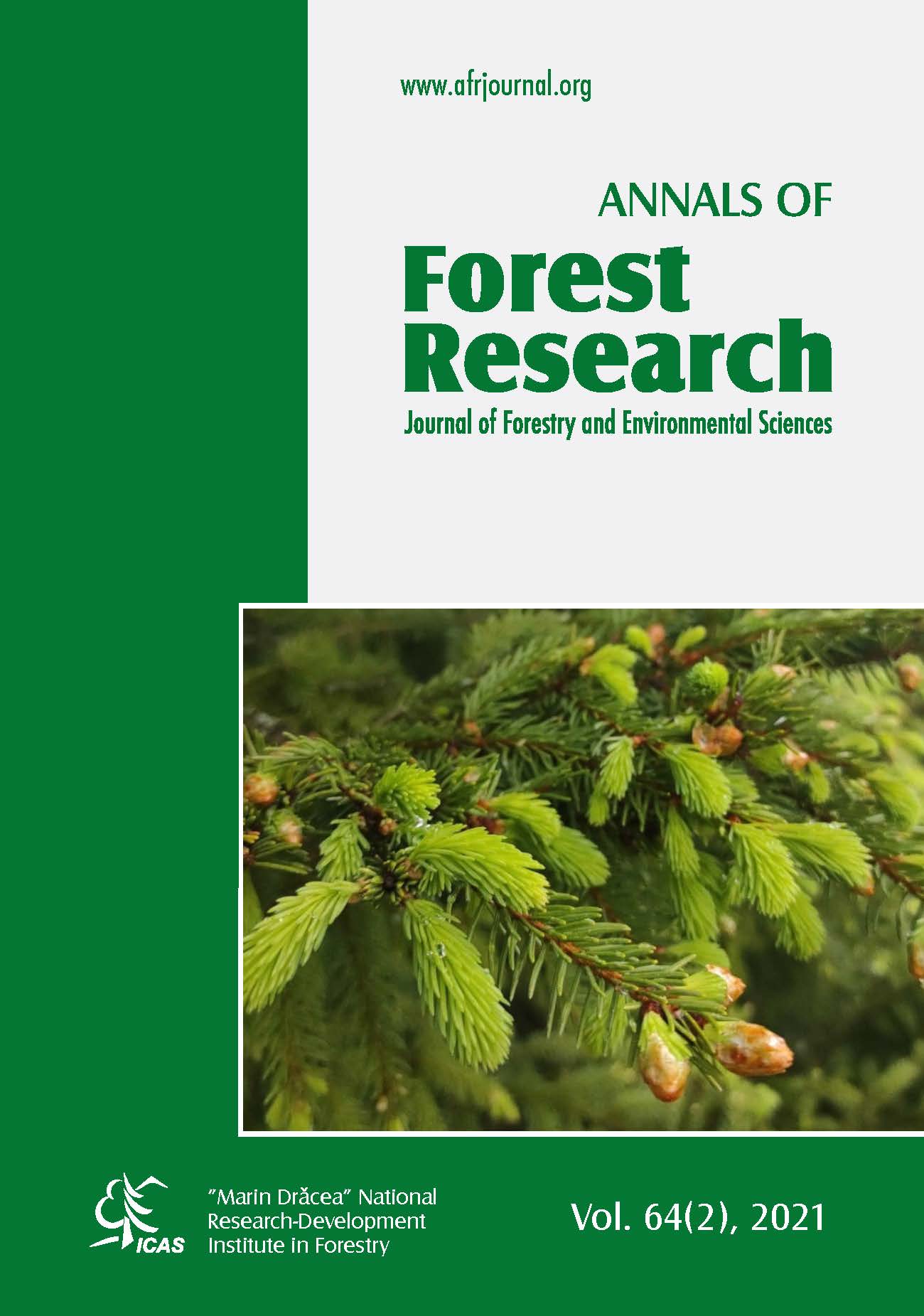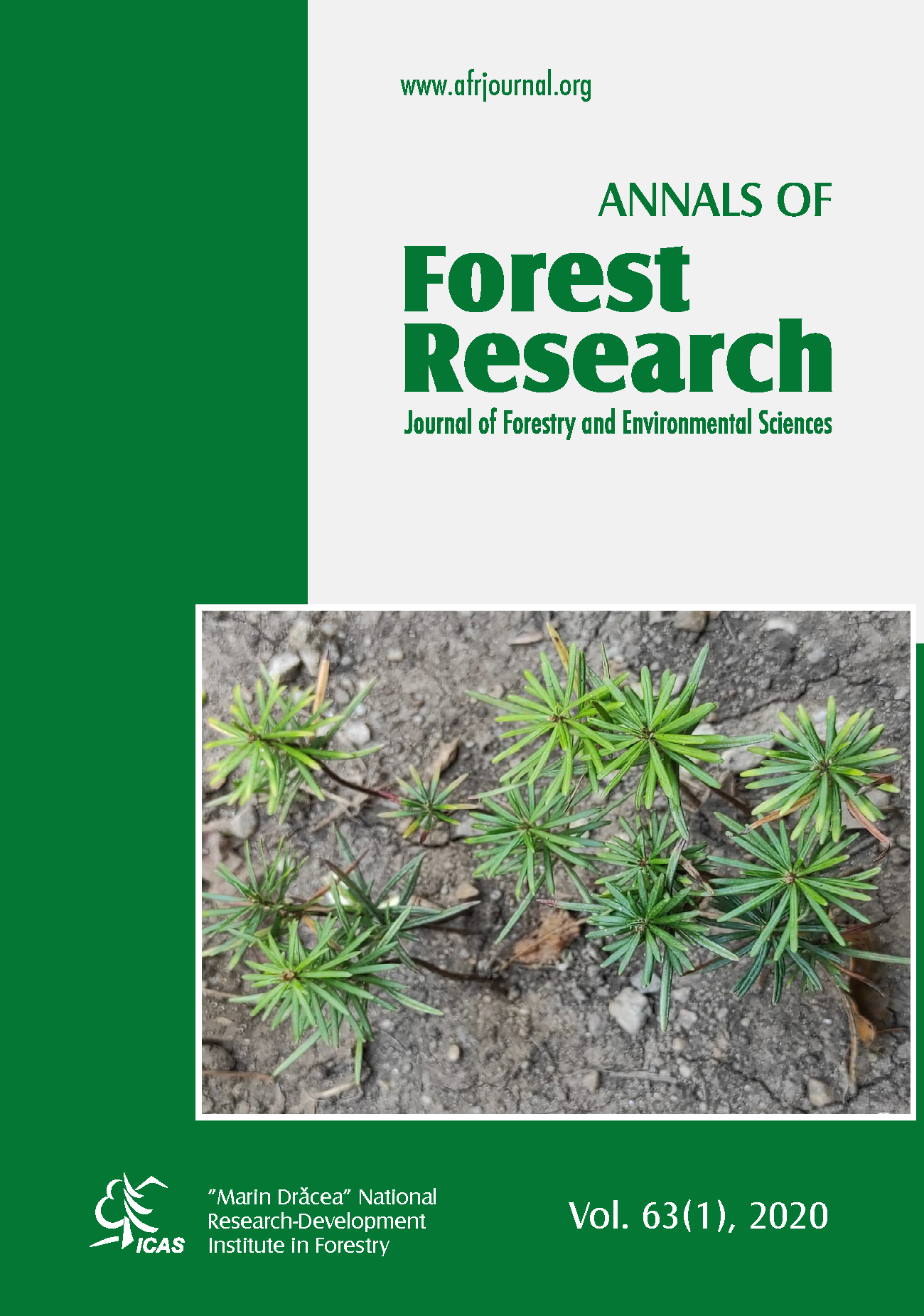Seasonal changes in water absorbability of some litterfall components in Scots pine stands differing in age
DOI:
https://doi.org/10.15287/afr.2021.2260Keywords:
Forest hydrology, water absorbability, internal capillarity, litterfall, litter layer, Pinus sylvestris L.Abstract
Understanding the water-holding capacity of the litter layer is of interest when constructing forest hydrology models, where the presence of litter affects soil moisture content and fire behavior. However, to understand the process of water storage in the litter layer it is not only important to know (i) how much water the litter layer can store, but also (ii) how much water particular litter components can store. Little is known about the role of organic matter chemistry in water absorption and saturation of its internal capillarity. We hypothesized that water absorption of freshly fallen organic matter changes with stand age and during the year, i.e. the term when organic matter falls (month of the year or season) affects its water absorbability. Thus, we determined seasonal changes in water absorption time, carbon and nitrogen contents, and the C/N ratio of bark and needles taken from Scots pine stands of different ages during laboratory tests. Pine needles and bark were collected every month for one year in five stands in north-western Poland. The time of water absorption for bark was about 30% shorter than that of needles. The age of the stand did not affect the time of water absorption in the litterfall components. We observed that the term when litter falls (month of the year or season) significantly affected the water absorption time. It indicates that organic matter reaching the forest floor and forming the litter layer is characterized by different output properties affecting the water storage capacity of the litter layer.
References
Berg B., Wessén B., 1984. Changes in organic-chemical components and ingrowth of fungal mycelium in decomposing birch leaf litter as compared to pine needles. Pedobiologia (Jena) 26(4): 285-298.
Berg B., Meentemeyer V., 2001. Litter fall in some European coniferous forests as dependent on climate: a synthesis. Canadian Journal of Forest Research 31(2): 292-301. https://doi.org/10.1139/x00-172
Blanco J.A., Imbert J.B., Castillo F.J., 2008. Nutrient return via litterfall in two contrasting Pinus sylvestris forests in the Pyrenees under different thinning intensities. Forest Ecology and Management 256(11): 1840-1852. https://doi.org/10.1016/j.foreco.2008.07.011
Brye K.R., Norman J.M., Bundy L.G., Gower S.T., 2000. Water‐budget evaluation of prairie and maize ecosystems. Soil Science Society of America Journal 64(2): 715-724. https://doi.org/10.2136/sssaj2000.642715x
Cuevas E., Lugo A.E., 1998. Dynamics of organic matter and nutrient return from litterfall in stands of ten tropical tree plantation species. Forest Ecology and Management: 112(3): 263-279. https://doi.org/10.1016/S0378-1127(98)00410-1
Du J., Niu J., Gao Z., Chen X., Zhang L., Li X., ..., Zhu Z., 2019. Effects of rainfall intensity and slope on interception and precipitation partitioning by forest litter layer. Catena 172: 711-718. https://doi.org/10.1016/j.catena.2018.09.036
Fernald A., Gallegos J., VanLeeuwen D., Baker T.T., 2012. Evaluation of litter hydrology in ponderosa pine and mixed conifer stands in northen New Mexico, USA. New Mexico Academy of Science 4: 121-136.
Fernández V., Sancho-Knapik D., Guzmán P., Peguero-Pina J.J., Gil L., Karabourniotis G., ..., Gil-Pelegrín E., 2014. Wettability, polarity, and water absorption of holm oak leaves: effect of leaf side and age. Plant Physiology 166(1): 168-180. https://doi.org/10.1104/pp.114.242040
Fife D.N., Nambiar E.K.S., 1984. Movement of nutrients in radiata pine needles in relation to the growth of shoots. Annals of Botany 54(3): 303-314. https://doi.org/10.1093/oxfordjournals.aob.a086801
Gerrits A.M.J., 2010. The role of interception in the hydrological cycle. VSSD.
Gerrits A.M.J., Savenije H.H.G., 2011. Forest floor interception. In Forest hydrology and biogeochemistry. Springer, Dordrecht, pp. 445-454.
Gonet S., Dębska B., Zaujec A., Banach-Szott M., Szombathowa N., 2007. Wpływ gatunku drzew i warunków glebowo-klimatycznych na właściwości próchnicy gleb leśnych–Rola materii organicznej w środowisku. PTSH, Wrocław: 61-98.
Greiffenhagen A., Wessolek G., Facklam M., Renger M., Stoffregen H., 2006. Hydraulic functions and water repellency of forest floor horizons on sandy soils. Geoderma 132(1-2): 182-195. https://doi.org/10.1016/j.geoderma.2005.05.006
Guevara-Escobar A., Gonzalez-Sosa E., Ramos-Salinas M., Hernandez-Delgado G.D., 2007. Experimental analysis of drainage and water storage of litter layers. Hydrology and Earth System Sciences 11(5): 1703-1716. https://doi.org/10.5194/hess-11-1703-2007
Helmisaari H.S., 1990. Temporal variation in nutrient concentrations of Pinus sylvestris needles. Scandinavian Journal of Forest Research 5(1-4): 177-193. https://doi.org/10.1080/02827589009382604
Helvey J.D., Patric J.H., 1965. Design criteria for interception studies. In Design of Hydrological Networks. Proceedings, pp. 131-137.
Ilek A., Kucza J., Szostek M., 2015. The effect of stand species composition on water storage capacity of the organic layers of forest soils. European Journal of Forest Research 134(1): 187-197. https://doi.org/10.1007/s10342-014-0842-2
Ilek A., Kucza J., Szostek M., 2017. The effect of the bulk density and the decomposition index of organic matter on the water storage capacity of the surface layers of forest soils. Geoderma 285: 27-34. https://doi.org/10.1016/j.geoderma.2016.09.025
Ilek A., Szostek M., Kucza J., Stanek-Tarkowska J., Witek W., 2019. The water absorbability of beech (Fagus sylvatica L.) and fir (Abies alba Mill.) organic matter in the forest floor. Annals of Forest Research 62(2): 21-32. https://doi.org/10.15287/afr.2018.1161
IUSS Working Group WRB, 2015. World reference base for soil resources 2014, update 2015: International soil classification system for naming soils and creating legends for soil maps. World Soil Resources Reports No. 106, 192.
Jasińska J., Sewerniak P., Puchałka R., 2020. Litterfall in a Scots pine forest on inland dunes in Central Europe: mass, seasonal dynamics and chemistry. Forests 11(6): 678. https://doi.org/10.3390/f11060678
Kim C., Son Y., Lee W.K., Jeong J., Noh N.J., 2009. Influences of forest tending works on carbon distribution and cycling in a Pinus densiflora S. et Z. stand in Korea. Forest Ecology and Management 257(5): 1420-1426. https://doi.org/10.1016/j.foreco.2008.12.015
Kim C., Jeong J., Cho H.S., Son Y., 2010. Carbon and nitrogen status of litterfall, litter decomposition and soil in even-aged larch, red pine and rigitaeda pine plantations. Journal of Plant Research 123(4): 403-409. https://doi.org/10.1007/s10265-010-0317-6
Krakau U.K., Liesebach M., Aronen T., Lelu-Walter M.A., Schneck V., 2013. Scots pine (Pinus sylvestris L.). In Forest tree breeding in Europe. Springer, Dordrecht, pp. 267-323. https://doi.org/10.1007/978-94-007-6146-9_6
Krishna M.P., Mohan M., 2017. Litter decomposition in forest ecosystems: a review. Energy, Ecology and Environment 2(4): 236-249. https://doi.org/10.1007/s40974-017-0064-9
Kucza J., 2007. Właściwości hydrologiczne materii organicznej gleb leśnych na przykładzie gleb pod świerczynami istebniańskimi. Zeszyty Naukowe Akademii Rolniczej w Krakowie. Rozprawy 320: 1-176.
Kucza J., Urbaś J., 2005. Water absorption of organic matter taken from horizons of ectohumus of forest soils under Norway spruce stands. EJPAU Forestry 8(4): 50-58.
Leuschner C., 1998. Water extraction by tree fine roots in the forest floor of a temperate Fagus-Quercus forest. In Annales des sciences forestières. EDP Sciences, 55 (1-2) : 141-157. https://doi.org/10.1051/forest:19980109
Li X., Xiao Q., Niu J., Dymond S., McPherson E.G., van Doorn N., ..., Li J., 2017. Rainfall interception by tree crown and leaf litter: An interactive process. Hydrological Processes 31(20): 3533-3542. https://doi.org/10.1002/hyp.11275
Li Q., Lee Y.E., Im S., 2020. Characterizing the interception capacity of floor litter with rainfall simulation experiments. Water 12(11): 3145. https://doi.org/10.3390/w12113145
Liski J., Perruchoud D., Karjalainen T., 2002. Increasing carbon stocks in the forest soils of western Europe. Forest Ecology and Management 169(1-2): 159-175. https://doi.org/10.1016/S0378-1127(02)00306-7
Maddelein D., Lust N., 1992. Soil and forest floor characteristics of Scots pine stands on drift sands. Silva Gandavensis 57. https://doi.org/10.21825/sg.v57i0.883
Malek S., Grabowski L., 2010. Content of macronutrients in needles and litterfall in Norway spruce stands of different age in the Potok Dupnianski catchment, the Silesian Beskid. Folia Forestalia Polonica, Series A, Forestry 52(2).
Matthews S., 2005. The water vapour conductance of Eucalyptus litter layers. Agricultural and Forest Meteorology 135(1-4): 73-81. https://doi.org/10.1016/j.agrformet.2005.10.004
Melillo J.M., Aber J.D., Muratore J.F., 1982. Nitrogen and lignin control of hardwood leaf litter decomposition dynamics. Ecology 63(3):621-626. https://doi.org/10.2307/1936780
Muukkonen P., 2005. Needle biomass turnover rates of Scots pine (Pinus sylvestris L.) derived from the needle-shed dynamics. Trees 19(3): 273-279. http://dx.doi.org/10.1007%2Fs00468-004-0381-4
Oberhuber W., Sehrt M., Kitz F., 2020. Hygroscopic properties of thin dead outer bark layers strongly influence stem diameter variations on short and long time scales in Scots pine (Pinus sylvestris L.). Agricultural and Forest Meteorology 290: 108026. https://doi.org/10.1016/j.agrformet.2020.108026
Ogée J., Brunet Y., 2002. A forest floor model for heat and moisture including a litter layer. Journal of Hydrology 255(1-4): 212-233. https://doi.org/10.1016/S0022-1694(01)00515-7
Osman K.T., 2013a. Forest Soils-Physical Properties of Forest Soils. In Forest Soils. Springer Netherlands, pp. 19-44. https://doi.org/10.1007/978-3-319-02541-4_2
Osman K.T., 2013b. Organic matter of forest soils. In Forest Soils. Springer, Cham, pp. 63-76. https://doi.org/10.1007/978-3-319-02541-4_4
Pausas J.G., 1997. Litter fall and litter decomposition in Pinus sylvestris forests of the eastern Pyrenees. Journal of Vegetation Science 8(5): 643-650. https://doi.org/10.2307/3237368
Pitman J.I., 1989. Rainfall interception by bracken litter — relationship between biomass, storage and drainage rate. Journal of Hydrology 111(1-4): 281-291. https://doi.org/10.1016/0022-1694(89)90265-5
Putuhena W.M., Cordery I., 1996. Estimation of interception capacity of the forest floor. Journal of Hydrology 180(1-4): 283-299. https://doi.org/10.1016/0022-1694(95)02883-8
Richardson D.M. (Ed.), 2000. Ecology and biogeography of Pinus. Cambridge University Press.
Sadeghi S.M.M., Gordon D.A., Van Stan II J.T., 2020. A global synthesis of throughfall and stemflow hydrometeorology. In: Precipitation partitioning by vegetation. Springer, Cham, pp. 49-70. https://doi.org/10.1007/978-3-030-29702-2_4
Santa Regina I., Tarazona T., 2001. Nutrient pools to the soil through organic matter and throughfall under a Scots pine plantation in the Sierra de la Demanda, Spain. European Journal of Soil Biology 37(2): 125-133. https://doi.org/10.1016/S1164-5563(01)01072-X
Sato Y., Kumagai T.O., Kume A., Otsuki K., Ogawa S., 2004. Experimental analysis of moisture dynamics of litter layers — the effects of rainfall conditions and leaf shapes. Hydrological Processes 18(16): 3007-3018. https://doi.org/10.1002/hyp.5746
Talhelm A.F., Smith A.M., 2018. Litter moisture adsorption is tied to tissue structure, chemistry, and energy concentration. Ecosphere 9(4): e02198. https://doi.org/10.1002/ecs2.2198
Thurow T.L., Blackburn W.H., Warren S.D., Taylor C.A., 1987. Rainfall interception by midgrass, shortgrass, and live oak mottes. Journal of Management, 40(5): 455-460. http://dx.doi.org/10.2307/3899611
Tsiko C.T., Makurira H., Gerrits A.M.J., Savenije H.H.G., 2012. Measuring forest floor and canopy interception in a savannah ecosystem. Physics and Chemistry of the Earth, Parts A/B/C 47: 122-127. https://doi.org/10.1016/j.pce.2011.06.009
Ukonmaanaho L., Merilä P., Nöjd P., Nieminen T.M., 2008. Litterfall production and nutrient return to the forest floor in Scots pine and Norway spruce stands in Finland. Boreal Environment Research 13(suppl. B): 67-91.
Vanninen P., Ylitalo H., Sievänen R., Mäkelä A., 1996. Effects of age and site quality on the distribution of biomass in Scots pine (Pinus sylvestris L.). Trees 10(4): 231-238.
Walsh R.P.D., Voigt P.J., 1977. Vegetation litter: an underestimated variable in hydrology and geomorphology. Journal of Biogeography: 253-274. https://doi.org/10.2307/3038060
Xing Z., Yan D., Wang D., Liu S., Dong G., 2018. Experimental analysis of the effect of forest litter cover on surface soil water dynamics under continuous rainless condition in North China. Kuwait Journal of Science 45(2): 75-83.
Yan T., Wang Z., Liao C., Xu W., Wan L., 2021. Effects of the morphological characteristics of plants on rainfall interception and kinetic energy. Journal of Hydrology 592: 125807. https://doi.org/10.1016/j.jhydrol.2020.125807
Zhang Z., Chen Y., Zhang Z., Cui H., Lei Y., Wang D., Sui J., 2006. Water-holding characteristics of litter in different forests at the Lianxiahe watershed. Frontiers of Forestry in China 1(4): 413-418. https://doi.org/10.1007/s11461-006-0046-0
Zhao L., Hou R., Fang Q., 2019. Differences in interception storage capacities of undecomposed broad-leaf and needle-leaf litter under simulated rainfall conditions. Forest Ecology and Management 446: 135-142. https://doi.org/10.1016/j.foreco.2019.05.043
Downloads
Published
Issue
Section
License
All the papers published in Annals of Forest Research are available under an open access policy (Gratis Gold Open Access Licence), which guaranty the free (of taxes) and unlimited access, for anyone, to entire content of the all published articles. The users are free to "read, copy, distribute, print, search or refers to the full text of these articles", as long they mention the source.
The other materials (texts, images, graphical elements presented on the Website) are protected by copyright.
The journal exerts a permanent quality check, based on an established protocol for publishing the manuscripts. The potential article to be published are evaluated (peer-review) by members of the Editorial Board or other collaborators with competences on the paper topics. The publishing of manuscript is free of charge, all the costs being supported by Forest Research and Management Institute.
More details about Open Access:
Wikipedia: http://en.wikipedia.org/wiki/Open_access






